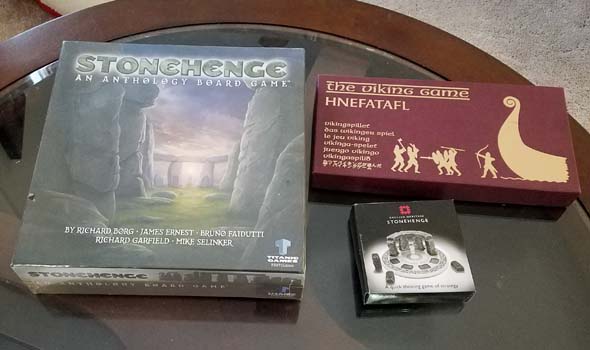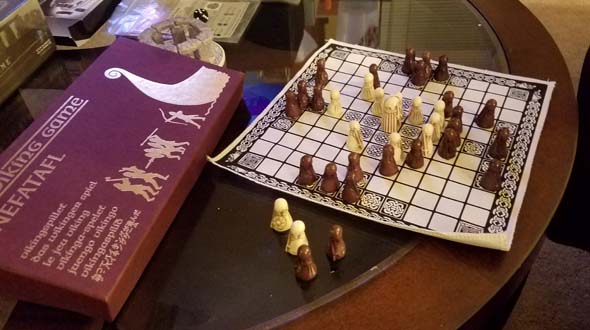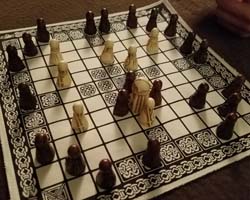
Souvenir board game!!!
During a holiday in Europe, I procured a few souvenir board games to add to my collection.
I didn't have room in my luggage for the larger Stonehenge Anthology Game or the Ring of Stones game. So instead of buying them in the Stonehenge gift shop, I ordered them online and had them shipped to my house. They were both waiting for me when I returned home from the trip! The Ring of Stones game was purchased directly from the English Heritage online shop's Stonehenge gifts section. The Anthology game had to come from Amazon because it isn't available from the English Heritage online shop, but I got a really good deal on it!
There was also some Stonehenge Monopoly and playing cards, but I'm not into those sorts of novelty variations that I can get anywhere. It was the unique games that caught my eye.
The third game that I brought back from Europe is a medieval Viking game called "Hnefatafl". I had seen it in the Viking Ship Museum gift shop when I was there last November, but I didn't buy it at the time because I wasn't sure if its rules were written in English or Danish. I didn't want to buy a game that I'd never be able to play because I couldn't read the rules. So when I saw the same game in the British Museum's gift shop this summer, I decided to go ahead and get it.

My European souvenir board games include 2 Stonehenge-themed games and a traditional Viking game.
I already talked about the Stonehenge Ring of Stones game and the anthology game, so today I will talk about the game that I should have bought in my first trip to Denmark: Hnefatafl (also called "The Viking Game" or "Viking Chess").
The Viking Game: Hnefatafl
While the previous Stonehenge-themed games are modern inventions, the Viking Game Hnefatafl (ne-fe-ta-fel) is a classic Norse game from the early middle ages. It was invented around 400 CE. It has some similarities to chess, but predates that game by at least 500 years. Besides, chess traces its lineage to India, so it's unlikely that Hnefatafl is a predecessor of chess.
Basically, Hnefatafl is an asymmetrical, chess-like game in which the single king and his defenders is ambushed and surrounded by the other player's pieces. All pieces move vertically or horizontally across the board (like rooks in chess), and pieces are killed/captured by flanking them on two opposing sides. The objective for the king's player is for the king to escape to any corner of the board; while the attacking player's objective is to defeat the king by surrounding it on all four orthogonally-adjacent spaces.

Hnefatafl is an asymmetrical, chess-like game in which a single king tries to escape from an ambush of attackers.
One of the things that makes the game a bit challenging (compared to chess) is that attacks can come from any direction, and every piece can hypothetically move the entire distance of the board.
As I understand it, the exact rules of the historical game are not fully known. No manuscripts or diagrams of the complete rules have ever been found, and so the rules that we have today are mostly extrapolated from the archaeological boards and pieces that have been found, some descriptions of the game in Norse folklore, as well as the cultural memory of the Scandinavian descendants of the Norse who played it. As such, there are many variations of the game's rules, and this particular set only provides one rule set.

Surrounding the King can be a tricky endeavor
Balance and variation
The rules (as written in this particular set) seems to heavily favor the king. He can participate in captures just like any other piece, and it is thus exceedingly difficult to surround him on all four sides without the attacker having his own pieces picked off one-by-one. Unless the king can be pinned on an edge of the board, or against his own "castle" square, it seems almost impossible for the attacker to actually win a round.
Or, at least, it seemed that way in my early play-sessions. As I figured out better strategies for the attacker, I started to see more captures of the king. I'm still not entirely sure that the game is balanced, but I'm also not sure that it's nearly as unbalanced as I initially thought. Nevertheless, that initial sense of imbalance did encourage me to experiment with several variations of the rules to see if any seemed to lead to more competitive games.
Some of the archaeological pieces that have been recovered were found alongside dice. It's unclear whether the dice were part of this game, or if the archaeologists had simply stumbled onto somebody's gaming collection. If they were part of this game, then the dice may have been a way of determining who plays as which side. So whether you get the "easy" side or the "hard" side might be dependent on whether the board game gods smile on you today. This set, however, does not come with a die.
If the game is, in fact, uneven, then one balancing mechanic would be to play two rounds with both players playing each side. The winner then becomes the player who manages to escape the king in the fewest moves, or the player who loses the fewest pieces in the process of escaping. Given the asymmetrical nature of the game, I feel like this variation of the rules is probably closest to how the original Norse players would have played it, as it requires both players to demonstrate a mastery of both sides of the game. Having to keep as many of your pieces alive as possible (being concerned for the lives of your troops) also adds an interesting dynamic to the game. This set's rulebook even does suggest playing multiple rounds, and the game is generally quick enough that doing so is not an undue burden.
Variants include taking away the king's ability to capture pieces, or to allow 2 attackers to capture the king.
Other common variations include "disarming" the king (such that the king cannot participate in captures of attacking pieces), or allowing the king to be captured by only two attacking pieces. Each of these variants may, however, shift balance more in favor of the attacker, so you'll have to experiment to find the variation that works for you and your playing group. A possible compromise variant might be to only allow the king to capture pieces if the king is the piece that moves to initiate the capture. This "King's Charge" variant (as a friend called it) would prevent the king's defenders from being able to easily pick off any attackers who are already surrounding the king, and may restore parity to the game.
Living Archaeology
I'd be interested in seeing some of the archaeological playing pieces that have been recovered to see if the historic kings were depicted as holding a weapon. If all the other pieces appear to be armed, but the king is not, then that would certainly imply that the king should not be armed. Of course, there was no standardized set of pieces, and most players carved their own pieces out of wood, bone, or ivory. So the archaeological pieces may not even be that detailed, and even if they are, they may not be representative of how the game was typically played.
Archaeological pieces aren't intricate enough to know if they were meant to represent a king carrying a weapon.
In any case, these discussions that I've had with my playing opponents about the game's rules and possible variants has been interesting. Talking about the game through the lens of the culture that played it is like a little archaeological thought experiment of our own.
For example, Viking kings were often warrior kings who were expected to lead troops into battle. So in that sense, it makes sense for the king to be armed. On the other hand, the asymmetrical board may be emblematic of the Viking raiding culture, and so the king's pieces may not represent a Viking tribe; they may represent the Vikings' victims. In that case, the king may not necessarily be able to fight. Heck, he might not even represent a "king" at all. He could represent loot being hidden away from the attacking raiders. Like I said, the game spawns some interesting conversations.
PROS
- Very easy to learn and play
- Simple, but compelling strategies
- Cloth board is very portable
- Nifty little collectible
- Sparks conversation about the game's cultural symbolism
CONS
- Players can easily drag the game on
- Beginner players will likely find escaping the king to be too easy
- Experienced players may find escaping the king to be too hard
Viking Game Hnefatafl FINAL GRADE: B
Original release: circa 400 ACE
MSRP: £25 GBP | 350 Danish Kr.
Player(s): 2 players
Game Length: less than 1 hour